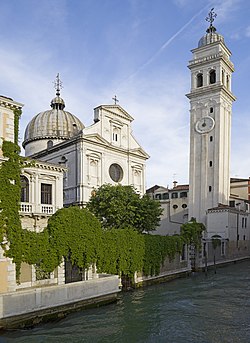Greek Orthodox Metropolis of Italy | |
|---|---|
| Orthodox | |
 Cathedral church of Saint George of the Greeks in Venice | |
| Location | |
| Country | Italy and San Marino |
| Headquarters | Venice |
| Statistics | |
| Parishes | 80 |
| Information | |
| Denomination | Eastern Orthodox |
| Rite | Byzantine Rite |
| Established | 1991 |
| Cathedral | San Giorgio dei Greci |
| Secular priests | 50 |
| Language | Greek and Italian |
| Current leadership | |
| Parent church | Ecumenical Patriarchate of Constantinople |
| Governance | Episcopal |
| Patriarch | Bartholomew I of Constantinople |
| Metropolitan | Polykarpos Stavropoulos |
| Auxiliary Bishops |
|
| Vicar General | Archimandrite Vissarion Vakaros |
| Website | |
| ortodossia.it/ | |
The Greek Orthodox Archdiocese of Italy (and Malta from 2005[ citation needed ] until the creation of the Exarchate of Malta in 2021), [1] officially the Sacred Orthodox Archdiocese of Italy and Exarchate of Southern Europe (Italian : Sacra Arcidiocesi Ortodossa d'Italia ed Esarcato per l'Europa Meridionale), is a diocese of the Ecumenical Patriarchate of Constantinople with its see in Venice. [2] The diocese was created in 1991.
Contents
The current archbishop and exarch is Polykarpos Stavropoulos. [3]
